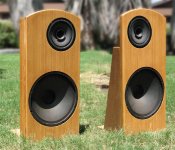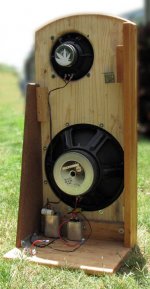so, actually we could set up a chart with certain selected variables..might be helpful in ceratin situations
Every application will have a limited number of solutions. For example even if a 12" has the same Sd and Xmax as 2 8" woofers the 8" woofers can be placed in MTM or push-push confingurations; not possible with the 12".
This might also apply to 2 woofers displacing approximately the same volume of air but having different Sd and Xmax. For example:
232 x 1.3cm = 301.6 cc. http://www.scan-speak.dk/datasheet/pdf/23w-4557t00.pdf
320 x 0.9cm = 288 cc. http://www.scan-speak.dk/datasheet/pdf/26w-8867t00.pdf
They are subsets. They are included in your decision, they just add up. I had to define the main Indicators at some point to be able to transform the subjective data in statistics data that can be compared (like in a math formula). You can have 4 indicators or 50 or 100, but you have to start in someplace.In addition to Inductor's list:
"1. - SIZE (L/FT3), for the enclosure
2. - F3 (Hz), for lower attenuation F3/F6/F12
3. - SPL (dB)
4. - PRICE "
since this is the Multi-way forum, I would add:
5. Upper frequency crossover point
6. Allowable distortion
When all the variables are considered, there is no one answer as far as which is better, multiple small woofers or a single large one.
I guess #5 you mention is for "high" crossover point like in the AE's, not (so much) for 3-Way type speaker but can be included, can you elaborate on your assertion. We can define (qualify/quantify) Le, shape of specs curves, max/min impedance.
We can add quality of the speaker driver basket #7 (pressed steel/die cast), surround material #8 (longevity/performance), aesthetics or personnel taste #9, overall quality #10...
Last edited:
No, wrong, there is answer after they are set. You calculate the weighted average for the parameters given....When all the variables are considered, there is no one answer as far as which is better, multiple small woofers or a single large one.
Yes, very much so. You can select the "best speaker driver" (the myth is over).so, actually we could set up a chart with certain selected variables
and the order in which they will be marked to be fixed will define the goal
and the defined goal will help to put in the variable specs
might be helpful in ceratin situations
You just need to give weighing or value in percentage for each of the parameters in question (the computer runs the test).
Every application will have a limited number of solutions.
hey, I didnt say it wouldnt still need brainwork
my reasoning is that it might help lesser skilled
and in the also us here, when asked how to choose a design, etc
we have these numbers in our head
but not all are able to
tinitus, I think you mentioned the Selenium 15PW3 once, long time ago.hey, I didnt say it wouldnt still need brainwork
my reasoning is that it might help lesser skilled
and in the also us here, when asked how to choose a design, etc
we have these numbers in our head
but not all are able to
It only runs open baffle, or if I'm wrong, correct me please. Thanks.
tinitus, I think you mentioned the Selenium 15PW3 once, long time ago.
that must be a very long time ago
cant remember anything about that driver
when was that, and in which connection
tinitus, I think you mentioned the Selenium 15PW3 once, long time ago.
It only runs open baffle, or if I'm wrong, correct me please. Thanks.
with 0.61 Qts, most likely
ahh, Im beginning to remember now
I think Pano might be the expert on this woofer
like you say, a dipole design
these 'weaker' woofers often tend to measure 'smoother'
and besides, it appears to have less deep shallow cone
which ought to improve upper frequencies
at the cost of lows


Good memory, Tinitus.
I have used the 15PW3 on open baffle and it was very nice. Good bass, not hard to crossover in the mids. One got damaged in the move from Hawaii, so I don't use the pair any longer. Too bad, nice 15" for OB.
I have used the 15PW3 on open baffle and it was very nice. Good bass, not hard to crossover in the mids. One got damaged in the move from Hawaii, so I don't use the pair any longer. Too bad, nice 15" for OB.
Attachments
Originally Posted by weltersys
...When all the variables are considered, there is no one answer as far as which is better, multiple small woofers or a single large one.
1. - SIZE (L/FT3), for the enclosure
is to be small, and has the highest weighting, a large woofer is eliminated.
Depending on weighting of each of the individual multiple parameters, multiple small woofers or a single large one could be of equal validity.
If we were to rate 10 parameters, each with a weighting of 1-10, 10 people would each likely rate them differently as far as importance, and the 11th may want another parameter most important to him added (cone material, color, whatever).
There is a place for 3 inch and 30 inch woofers and every size in between.
...When all the variables are considered, there is no one answer as far as which is better, multiple small woofers or a single large one.
If:No, wrong, there is answer after they are set. You calculate the weighted average for the parameters given.
1. - SIZE (L/FT3), for the enclosure
is to be small, and has the highest weighting, a large woofer is eliminated.
Depending on weighting of each of the individual multiple parameters, multiple small woofers or a single large one could be of equal validity.
If we were to rate 10 parameters, each with a weighting of 1-10, 10 people would each likely rate them differently as far as importance, and the 11th may want another parameter most important to him added (cone material, color, whatever).
There is a place for 3 inch and 30 inch woofers and every size in between.
No, I meant or read likeOriginally Posted by weltersys
...When all the variables are considered, there is no one answer as far as which is better, multiple small woofers or a single large one.
If:
1. - SIZE (L/FT3), for the enclosure
is to be small, and has the highest weighting, a large woofer is eliminated.
1. - VOLUME (L/FT3), for the enclosure
So that all drivers are compared for/to the smallest enclosure possible.
Example: An AE speakers TD10S would model in an enclosure of 38.9 L what is about half of the average. A 10" Alcone AC10HE also would have a good rating because of small volume enclosure of 47.8 L, and so on. A driver requiring an enclosure of 125 L is a bad driver (read rating).
I agree with the most part of it (from all what I could understand)....Depending on weighting of each of the individual multiple parameters, multiple small woofers or a single large one could be of equal validity.
If we were to rate 10 parameters, each with a weighting of 1-10, 10 people would each likely rate them differently as far as importance, and the 11th may want another parameter most important to him added (cone material, color, whatever).
There is a place for 3 inch and 30 inch woofers and every size in between.
What's the RLC for the dumping of the peak resonance (if you have it, to compare w. the one from the formulas I have)? Thanks.Good memory, Tinitus.
I have used the 15PW3 on open baffle and it was very nice. Good bass, not hard to crossover in the mids. One got damaged in the move from Hawaii, so I don't use the pair any longer. Too bad, nice 15" for OB.
If we were to rate 10 parameters, each with a weighting of 1-10, 10 people would each likely rate them differently as far as importance
that was the whole point of it
Nobody said which 6.5" and 15" we are talking about or to compare, that's the funny part.
Comparing a bank of 6 x 6.5" (Sd 140cm2 x 6) to a 15" (Sd of 840 cm2) is going to be diffcult. Most 15" will need a bigger box than 6 6.5".
Most 15" (JBL 2235, Eminence 1550, AE TD15m) are designed for big systems with big boxes etc..while small woofers like the 6.5" like the Tang Band W6-1139/1936, Aurum Cantus AC-180, etc are built for car audio or small subs like this DIY one Cerberus or this one from Velodyne Impact-Mini 6.5" Subwoofer or to complement soundbars or "Acoustimass" style systems.
Depending on weighting of each of the individual multiple parameters, multiple small woofers or a single large one could be of equal validity.
There is a place for 3 inch and 30 inch woofers and every size in between.
I agree. Each one of us would weigh each parameter differently depending on the application.
I wonder if we are talking about 'movie effects', instead of music
NO! We are talking bass with notes and kick drums the KICK. Not the one note, harmonically distorted, floppy port sounds of most subs.
People say the bass is like being hit.
Good bass will 'hit' you, but let's keep it within reason. FWIW, I like my bass a little trumped up (but clean) in my car because I'm out and I want to stay alert and enjoy myself.
A real kick drum does not 'kick' the way it seems so many people make out that it should. At home I like to be able to hear the beater hit the head, and hear the batter head crinkle when the drummer has it tuned low, before feeling it plumb then decay.
Once there was a company named Polk. I still keep a pair of Monitor 10's for backup shop audio. They do benefit from using a PR instead of a whoosh hole, like the current "Polk" stuff.
Whoosh hole... gotta remember that one.
I like passive radiators over ports since they physically block other notes, are easy to change tuning and bugs/critters or kids won't get inside the box.
Loved the old Polk Audio Monitor and SDA series even the funky looking silver tweeters grew on me.
Polk Audio from the 80's would vote to use eight 6.5 inch woofers and a 15 inch passive radiator.

Agreed. Not many real instruments have the kick or slam that's so popular in reproduction. Mostly the slam is an effect achieved with large drivers and 100s of watts. EQ is usually needed, as well.A real kick drum does not 'kick' the way it seems so many people make out that it should.
It's quite a popular and fun effect in amplified music and car audio, but hardly exists in acoustic music. It's a large cone + amplifier thing.
- Status
- This old topic is closed. If you want to reopen this topic, contact a moderator using the "Report Post" button.
- Home
- Loudspeakers
- Multi-Way
- One "big" woofer or four "small"?

